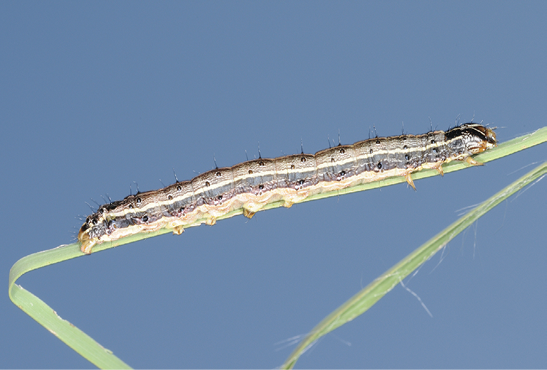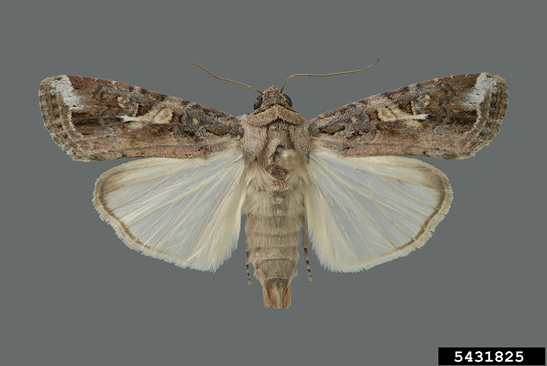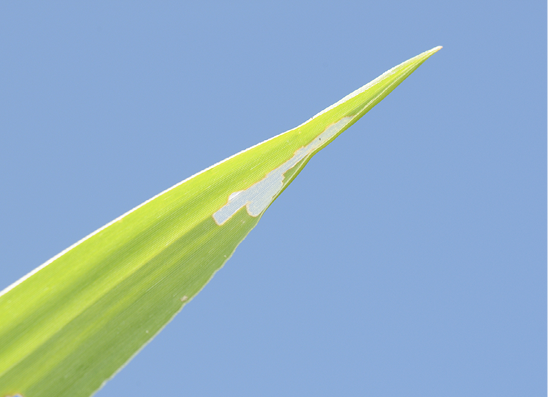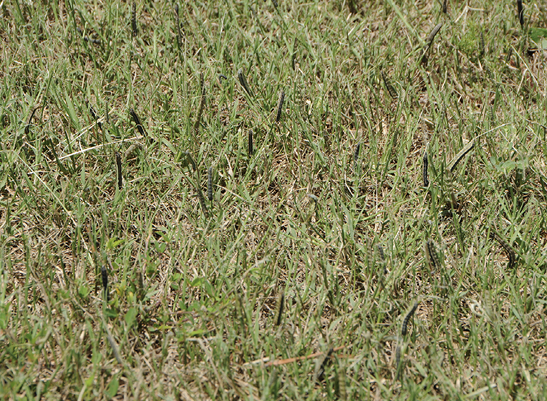Fall Armyworms in Hayfields and Pastures
Fall armyworms are the most damaging insect pests of Mississippi hayfields and pastures. These caterpillars can destroy a cutting of bermudagrass in just a few days, and good bermudagrass can produce a few hundred dollars’ worth of hay per acre! Experienced cattle and hay producers know to look for fall armyworms throughout the growing season and to be ready to treat quickly when damaging infestations occur.
Fall armyworms are unpredictable pests. Some years, high populations do not occur until early fall, and the most heavily infested fields require only one or two sprays. Other years, damaging infestations appear as early as June, and some fields require six or more treatments. One reason they are so unpredictable is that fall armyworms cannot survive the winter here in Mississippi. Populations rebuild every year from moths that fly in from locations farther south, such as South America, the Caribbean Islands, and southern Florida. Some years, the moths arrive earlier than others or find better growing conditions once they get here. This is also the reason infestations usually occur earlier and more often in the southern part of the state and populations are highest in late summer and fall. After they fly in from the south, it usually takes them a few generations to build to damaging numbers.
Identification
Fall armyworm caterpillars vary in color depending on their stage of development and diet. Most are green or tan, but some can be dark brown to almost black, especially late in the year when numbers are high (Figure 1). The body is punctuated with dark spots. Most notably, there are four spots at the rear of the body that form a square. Mature caterpillars are about 11/2 inch long and are mostly slick-bodied with a few small, stiff hairs visible up close. The head capsule ranges from light brown to dark brown, and, on larger specimens, there is a distinct white inverted Y shape on the head. This Y and the square of four spots on the rear are two of the best ways to identify fall armyworm caterpillars (Figure 2).

Figure 1. Fall armyworm caterpillars vary considerably in color, ranging from light green to nearly black.

Fall armyworm moths are about three-fourths of an inch long when resting with their wings folded. The forewings are gray to dark brown, but the underwings are white, which causes the moths to appear pale when in flight. Males have more white markings on their forewings than females do (Figure 3). Moths are active at night and spend the day resting in foliage. You will not often see the moths unless you go out at night with a spotlight to look for them or happen to flush one from its daytime resting place.

Biology
Fall armyworm moths lay their eggs in clusters, or masses, containing around 50 eggs each. They cover each egg mass with light-colored scales from their bodies, giving the egg mass a white, fuzzy appearance. Eggs hatch in 2–5 days, and the newly emerged larvae scatter out and begin feeding (Table 1). They usually begin by feeding on the underside of the leaf blade, and at first they do not feed through the clear upper epidermis. Their feeding habits result in tiny, white “windowpanes” in the leaf blades or a white frizzing of the leaf tips. Experienced cattle producers watch for this white frosting or frizzing of the leaf tips as an early warning of fall armyworm infestation.
|
Stage of development |
Duration (days)* |
|---|---|
|
Egg |
2–5 |
|
Caterpillar |
10–22 |
|
Pupa |
6–15 |
|
Adult pre-oviposition |
4 |
|
Total time for one generation |
22–46 |
Female moths live about 14 days and lay 1,000–2,000 eggs.
*Development rate depends on temperature.
Caterpillars take about 14 days to complete their larval development, and it takes about a month to complete a generation, but development rate varies considerably depending on temperature and other factors. As with most caterpillars, about 80 percent of total leaf consumption occurs in the last 2–3 days of the caterpillar stage. This is why fall armyworm damage can occur so quickly; grass that looked fine Friday morning can be nothing but stems by Monday afternoon.
Fall armyworm caterpillars pupate by digging about an inch into the soil and forming a pupal chamber. Newly emerged female moths use pheromones to attract males. Mating occurs a few days after emergence, and females lay eggs about 4 days after emergence. Female moths live a couple of weeks and deposit around 1,500 eggs during their lifetimes.
Depending on how early in the season fall armyworms arrive in an area, there can be two to five generations per year. Populations grow larger, often exponentially larger, with each generation. The moth flight of a given generation lasts a couple of weeks, and generations overlap by late summer. During heavy outbreaks, there can be almost continuous pressure, with new egg masses deposited every night.
Food Plants
Fall armyworms are primarily pests of grasses, including agricultural crops such as corn, sorghum, rice and millet. They especially like bermudagrass, regardless of whether it is a dwarf variety growing on a golf green, a field of sports turf, or a forage variety being grown for hay. Lush, well-fertilized grass is particularly attractive to egg-laying moths, and this is why infestations are so common in well-managed bermudagrass hayfields. Fall armyworms will eat other types of forage grass, and fields of bahiagrass, dallisgrass and other grasses are sometimes heavily attacked. Again, such infestations are more likely on well-managed, highly fertilized fields. Some wide-leafed weedy grasses, such as barnyardgrass and broadleaf signalgrass, are more preferred than bermudagrass, and cattlemen and hay producers learn to watch stands of these grasses as an early indicator of fall armyworm problems. Fall armyworms will also attack early planted winter grazing crops like wheat and ryegrass and sometimes destroy stands as these crops are emerging. Newly emerging crops can be seriously damaged by much lower populations that are required to damage established stands of perennial grasses.
Be Prepared
Don’t wait until the hayfield is teeming with big caterpillars to start thinking about the equipment you are going to use to spray them. Get your sprayer ready early in the season: be sure it is cleaned, repaired, and calibrated. Then you can act quickly when it is time to treat. It is also a good idea to know ahead of time what insecticide you plan to use, where you can buy it, how much it costs, and how quickly you can get it. If you plan to use one of the pyrethroid insecticides, be sure your pesticide applicator certification is up-to-date.
Warning Signs
Experienced forage producers learn to recognize the early signs of fall armyworm feeding. Newly hatched caterpillars are too small to feed all the way through a leaf blade. They begin by feeding on the underside of the leaf but leave the clear upper epidermis intact. This creates tiny “windowpanes” in the grass blades that appear silver or white (Figure 4). When large numbers of small larvae are just beginning to damage a field, the grass often has a subtle “frosted” appearance because of these windowpanes. This is easier to see on the wide leaf blades of barnyard grass, which is a favorite food of fall armyworms. Learning what this looks like on barnyard grass can help you recognize it on bermudagrass. Recognizing this early sign of infestation can help save a cutting of hay.

Many producers watch for egrets and other birds feeding in a field as an indicator of fall armyworm problems. If you see birds in the pasture, you definitely want to check out what they are feeding on, but do not use this as your only way to check for armyworms. This sign often comes too late to avoid damage because the birds don’t show up until the caterpillars are big enough to attract their attention.
Producers also become concerned about fall armyworms if they notice large numbers of moths flying in the headlights as they are driving through a field after dark. However, there are many other species of moths that occur in and around grass fields, sometimes in large numbers. Seeing large numbers of moths flying around your pasture or hay field is not sufficient reason to start spraying, but it is a good reason to start checking the field more closely for caterpillars.
Scouting and Treatment Threshold
The best way to avoid losing a cutting of hay to fall armyworms is to visit fields every 3 or 4 days and check for fall armyworms. Get out of the truck, get down on your hands and knees, and look closely. Scout for fall armyworms by vigorously ruffling the grass with your fingers and carefully counting the larvae that have fallen to the ground in a 1-square-foot area. Do this at several locations in the field and average your results. Treatment is recommended when counts exceed three caterpillars that are one-fourth inch or longer per square foot (Figure 5). Be sure to look carefully for small caterpillars. You want to find and treat them when they are small because small caterpillars are easier to control and, more importantly, have not eaten nearly as much as they are going to eat.

Like most caterpillars, fall armyworms do about 80 percent of their eating during their last two to three days as larvae—when they are “teenage” caterpillars. Therefore, if a field has reached threshold on Friday but is not scheduled to be cut until the next week, it needs to be treated as soon as possible. A moderate to heavy population of large fall armyworm caterpillars can eat a whole field of grass in just a couple of days (Figure 6). Be sure to pay attention to preharvest intervals when choosing an insecticide to use on a field that is near cutting!

Deciding Whether to Spray or to Cut
One option for dealing with an infestation of fall armyworms in hay fields is to just go ahead and cut the field. This can be a good choice, but only if the field is nearly ready to cut anyway and the forecast promises good hay-curing weather. Be careful with this decision. If there are a lot of big caterpillars, they will “cut the field” for you in another couple of days. If you decide to go ahead and cut the field, you need to do it that day or the next morning. If there are threshold numbers of caterpillars and it will be 2 days or more before you can cut the field, you probably need to go ahead and spray.
When to Stop Scouting for Fall Armyworms
They are called fall armyworms because their populations are usually highest in the fall. In other words, they can damage the last cutting of hay if you stop scouting too early. During heavy outbreak years, fall armyworms will even destroy stands of early-planted winter grass crops, such as wheat and ryegrass. Delaying planting until later in the fall is one way to avoid this problem. If you do plant winter grazing crops in early fall, check fields often and treat promptly if you detect an infestation. Be especially vigilant during years when fall armyworm pressure has been high in hayfields and pastures. It takes fewer caterpillars to destroy a field of emerging ryegrass than to eat a lush field of bermudagrass.
Like all insects, fall armyworm development rate is greatly affected by temperature. In one laboratory study, conducted with caterpillars feeding on corn leaves at constant temperatures, the larval stage lasted about 22 days at 70 degrees, 14 days at 80 degrees, and 10 days at 90 degrees. As you can see, development rate is faster at higher temperatures, although it does begin to decline at temperatures above 93 degrees. Fall armyworms cannot survive freezing temperatures. Populations usually begin to decline a little before first frost because fall armyworms cannot develop at temperatures below about 50°F.
The bottom line here is that you need to be concerned about fall armyworms in late fall hayfields and early-planted winter grazing pastures until you stop seeing fall armyworms. Some years the threat of fall armyworm infestations lasts longer than others. It depends on the weather, and late infestations are more likely during warm, “late” falls.
Insecticides for Fall Armyworms
Although some older fall armyworm products like Sevin and Malathion are still available, there are many new products that are cheaper, more effective, provide longer residual control, and/or have more favorable pre-harvest intervals. These include several pyrethroid insecticides (zeta-cypermethrin, cyfluthrin, and gamma-cyhalothrin) and two insect growth disruptors (methoxyfenozide and diflubenzuron), as well as several more caterpillar specific products (chlorantraniliprole and spinosad). Growers need to be aware of the relative strengths and fit for each of these groups of insecticides.
The pyrethroid insecticides are all restricted use products, which means you must have a current pesticide applicator certification card to be able to buy and use these products. If you have significant acreage, it is worth the time and effort to get this certification because pyrethroids are effective, low-cost fall armyworm treatments. The growth regulator diflubenzuron is also restricted use. The primary reason for the restricted use classification is because of buffer zones along streams and around other bodies of water. See labels for specific details.
|
Active ingredient (brand name) |
Rate of formulated product per acre |
Acres 1 gallon (or pound) of product will treat |
Pregrazing interval |
Preharvest interval (wait to cut hay) |
|---|---|---|---|---|
|
methoxyfenozide (Intrepid 2F) |
4–8 fl oz |
32–16 |
0 days |
7 days |
|
diflubenzuron (Dimilin 2L1) |
2 fl oz |
64 |
0 days |
1day |
|
spinosad (Blackhawk 36% WDG) |
1.1–2.2 fl oz. |
14.5–7.3 |
until spray dries |
3 days |
|
chlorantraniliprole |
10-13 fl. oz.2 |
12.8 – 9.8 |
0 days |
0 days |
|
chlorantraniliprole (Vantacor 5.0) |
0.9-1.1 oz.3 |
142 - 116 |
0 days |
0 days |
|
chlorantraniliprole |
3.5-5.0 fl. oz. |
37 - 26 |
0 days |
0 days |
|
zeta-cypermethrin (Mustang Max 0.8 EC) Restricted use |
2.8–4.0 fl oz. |
45–32 |
0 days |
0 days |
|
beta-cyfluthrin (Baythroid XL, 1 lb/gal) Restricted use |
1.6–1.9 fl oz. |
80–67 |
0 days |
0 days |
|
Gamma-cyhalothrin (Declare 1.25) Restricted use |
1.02-1.54 oz. |
125-83 |
1 day |
7 days |
|
carbaryl (Sevin XLR 4F) |
1–1.5 qt. |
4–2.6 |
14 days |
14 days |
|
malathion (Malathion 57EC) |
1 qt. |
4 |
until spray dries |
0 days |
1 When applied to pastures that are being grazed, Dimilin will provide approximately 2 weeks of control of horn flies emerging from manure patties.
2 Use rate given on the main Prevathon label is 14-20 fl. Oz./acre. But a FIFRA 2(ee) label allows use for fall armyworm control in Mississippi at 10-13 fl. oz./acre. Expires Dec. 31, 2025. This 2(ee) label must be in the user’s possession when using this lower rate.
3 Use rate given on the main Vantacor label is 1.2-2.5 fl. Oz./acre. But a FIFRA 2(ee) label allows use for fall armyworm control in Mississippi at 0.9 to 1.1 fl. oz./acre. Expires Dec. 31, 2026. This 2(ee) label must be in the user’s possession when using this lower rate.
*This information is for preliminary planning purposes only. Carefully read the label of any product you plan to use, and follow all label directions and restrictions.
In addition to the brand name pyrethroids listed in Table 2, there are many generic pyrethroid products that are also labeled for use in forage crops. However, growers should be aware that not all pyrethroid products are labeled for use in hayfields and pastures. Check labels carefully before purchasing and applying products to be sure they are labeled for the intended use. If the label does not give specific information on use rates, preharvest interval and pre-grazing interval for hayfields and pastures, then the product is not labeled for use in hayfields and pastures.
Table 2 lists treatment options for fall armyworms in hayfields and pastures. Although a rate range is given for most products, the low to mid-range rate is usually adequate in most situations. When selecting insecticides pay close attention to the preharvest interval and note that preharvest intervals can vary depending on whether the grass will be grazed or cut for hay. Also note that “days to harvest” means days till cutting, not bailing.
When purchasing insecticides, you may also want to consider the number of acres one gallon of product will cover, the size of container the product is sold in, and the size of field you need to spray. When treating smaller fields, the most economical option may be to choose a product/container size that will best “fit the field.”
When treating large acreages, it is worthwhile to compare costs on a per acre basis. When comparing costs, keep in mind some products provide longer residual control than others. During years of heavy fall armyworm pressure, this can make the difference between having to spray once or twice rather than two or three times to make a cutting of hay. In general, the growth disruptor products (methoxyfenozide and diflubenzuron) provide longer control than the pyrethroids (zeta-cypermethrin, cyfluthrin, and gamma-cyhalothrin), but growth regulators are slower-acting and are best used when caterpillars are small. Because rapidly growing grass results in new, untreated leaf area and dilutes insecticide residues, few treatments will provide more than about two weeks of control. Residual control may be considerably shorter during heavy outbreaks or following frequent or heavy rainfall.
Since they became readily available for use in forage crops, pyrethroids alone have been the standard treatment for fall armyworms, because of their high efficacy and low cost. However, in the heavy outbreak year of 2021 many producers experienced reduced control with pyrethroids alone, and growers who shifted to combinations of products, such as a pyrethroid plus one of the growth regulators (Intrepid or Dimilin), or who used one of the other caterpillar products (chlorantraniliprole or spinosad) experienced better or longer-lasting control.
In some situations, it may be beneficial to apply a tank mix of two different products, with the first component of the tank mix being one of the pyrethroid insecticides (zeta-cypermethrin, cyfluthrin, or gamma-cyhalothrin) and the second component being one of the growth disruptors (methoxyfenozide or diflubenzuron). This takes advantage of the fast-killing effect of the pyrethroid and the longer residual control provided by the growth regulator product. For example, if you have to spray a field you expect to harvest within 10-14 days or so, including a growth disruptor with the pyrethroid may help you avoid having to spray again before harvest.
Although the caterpillar specific treatments (chlorantraniliprole and spinosad) are more costly than pyrethroids alone, they become more cost competitive when compared to the cost of a pyrethroid plus a growth regulator. Because these products tend to provide high levels of relatively long-lasting control when applied alone, it is not usually necessary to tank mix with one of the growth regulators.
Fall armyworms populations are cyclic and vary greatly from year to year. During years of unusually high populations, it is not unusual to have to spray multiple times on a single cutting of hay. This is not necessarily an indication of insecticide failure or resistance but is more likely due to sustained immigration of egg-laying moths and/or unusually high infestation levels. (For example, if there are 30 caterpillars per square foot, even 90 percent control still leaves three per square foot, which is threshold level.) During heavy outbreak years it becomes even more important for growers to check fields regularly and be prepared to treat promptly.
This work is partially supported by Crop Protection and Pest Management, Extension Implementation Program grant no. 2017-70006-27200/project accession no. 1014037 from the USDA National Institute of Food and Agriculture. Any opinions, findings, conclusions, or recommendations expressed in this publication are those of the author(s) and do not necessarily reflect the view of the U.S. Department of Agriculture.
Publication 2717 (POD-10-21)
By Blake Layton, PhD, Extension Professor, Biochemistry, Molecular Biology, Entomology, and Plant Pathology.
The Mississippi State University Extension Service is working to ensure all web content is accessible to all users. If you need assistance accessing any of our content, please email the webteam or call 662-325-2262.

